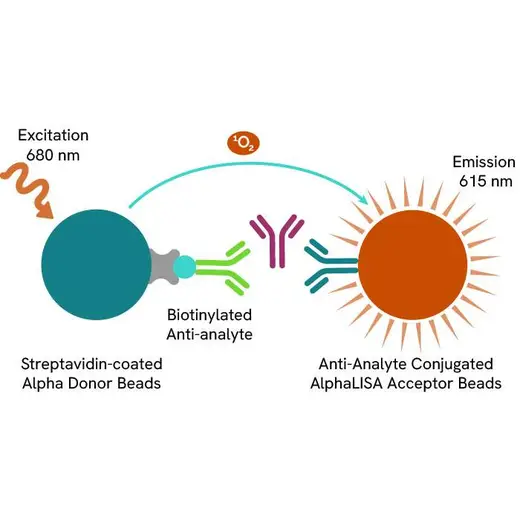
AlphaLISA Human IL-4 Detection Kit, 5,000 Assay Points


 View All
View All
AlphaLISA Human IL-4 Detection Kit, 5,000 Assay Points














The AlphaLISA™ Human Interleukin 4 (IL4) Detection Kit is designed for detection and quantitation of human IL4 in serum, buffered solution or cell culture medium in a homogeneous (no-wash steps, no separation steps) assay.
For research use only. Not for use in diagnostic procedures. All products to be used in accordance with applicable laws and regulations including without limitation, consumption and disposal requirements under European REACH regulations (EC 1907/2006).
| Feature | Specification |
|---|---|
| Application | Protein Quantification |
| Dynamic Range | 4.0 - 100,000 pg/mL |
| Limit of Detection | 4.0 pg/mL |
| Sample Volume | 5 µL |
The AlphaLISA™ Human Interleukin 4 (IL4) Detection Kit is designed for detection and quantitation of human IL4 in serum, buffered solution or cell culture medium in a homogeneous (no-wash steps, no separation steps) assay.
For research use only. Not for use in diagnostic procedures. All products to be used in accordance with applicable laws and regulations including without limitation, consumption and disposal requirements under European REACH regulations (EC 1907/2006).







AlphaLISA Human IL-4 Detection Kit, 5,000 Assay Points







AlphaLISA Human IL-4 Detection Kit, 5,000 Assay Points







Product information
Overview
Formats:
- Our 500 assay point kit allows you to run 500 wells in 96-well or 384-well format, using a 50 µL reaction volume (5 µL of sample).
- Our 5,000 assay point kit allows you to run 5,000 wells in 96-well or 384-well format, using a 50 µL reaction volume (5 µL of sample).
Features:
- No-wash steps, no separation steps
- ELISA alternative technology
- Sensitive detection
- Broad sample compatibility
- Small sample volume
- Results in less than 3 hours
- Half the time of an ELISA assay
Human Interleukin 4 (IL4), also known as B Cell Stimulatory Factor 1, is an anti-inflammatory glycoprotein of 129 amino acids. It is produced by a variety of cells including Th2, mast cells, and basophils. Via binding to type 1 IL4 receptor, IL4 acts on hematopoietic cells and promotes class switching to IgE. A high level of IL4 has been associated with an increased production of IgE and allergy. This cytokine suppresses IFN-? and IL-8 production. It inhibits the production of inflammatory cytokines (IL1, IL6, and TNFa). In vivo, injection of IL4 has been shown to protect against experimental arthritis and immune complex-induced lung inflammation in rats. It could potentially be used in the treatment of chronic inflammatory diseases. IL4 may also play a role in the pathogenesis of chronic lymphocytic leukemia.
AlphaLISA technology allows the detection of molecules of interest in a no-wash, highly sensitive, quantitative assay. In an AlphaLISA assay, a biotinylated anti-analyte antibody binds to the Streptavidin-coated Donor beads while another anti-analyte antibody is conjugated to AlphaLISA Acceptor beads. In the presence of the analyte, the beads come into close proximity. The excitation of the Donor beads causes the release of singlet oxygen molecules that triggers a cascade of energy transfer in the Acceptor beads, resulting in a sharp peak of light emission at 615 nm.
Specifications
| Application |
Protein Quantification
|
|---|---|
| Automation Compatible |
Yes
|
| Brand |
AlphaLISA
|
| Detection Modality |
Alpha
|
| Dynamic Range |
4.0 - 100,000 pg/mL
|
| Limit of Detection |
4.0 pg/mL
|
| Product Group |
Kit
|
| Sample Volume |
5 µL
|
| Shipping Conditions |
Shipped in Blue Ice
|
| Target |
IL4
|
| Target Class |
Cytokines
|
| Target Species |
Human
|
| Technology |
Alpha
|
| Therapeutic Area |
Inflammation
|
| Unit Size |
5,000 Assay Points
|
Image gallery






AlphaLISA Human IL-4 Detection Kit, 5,000 Assay Points






AlphaLISA Human IL-4 Detection Kit, 5,000 Assay Points






Video gallery

AlphaLISA Human IL-4 Detection Kit, 5,000 Assay Points

AlphaLISA Human IL-4 Detection Kit, 5,000 Assay Points

Resources
Are you looking for resources, click on the resource type to explore further.
Emerging pathways to neuroinflammation and neurodegeneration
Neurodegenerative diseases, such as amyotrophic lateral sclerosis...
Cytokines play a vital role in both innate and adaptive immunity and are known for their ability to exert diverse functions on...


How can we help you?
We are here to answer your questions.






























